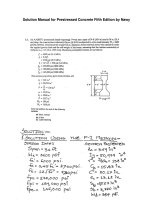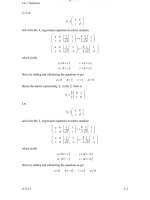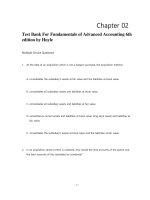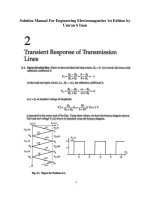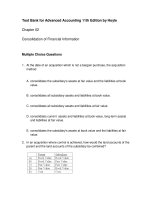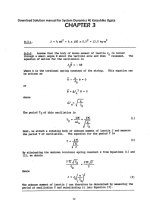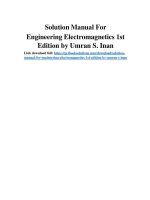Link download solution manual for advanced accounting 6th edition by jeter
Bạn đang xem bản rút gọn của tài liệu. Xem và tải ngay bản đầy đủ của tài liệu tại đây (479.73 KB, 11 trang )
SOLUTION MANUAL FOR ADVANCED
ACCOUNTING 6TH EDITION BY JETER
Chapter 2 – Accounting For Business Combinations
2.1
ACCOUNTING STANDARDS ON BUSINESS
COMBINATIONS: BACKGROUND
A.
Accounting standards now mandate the use of the acquisition
(purchase) method for accounting for mergers & acquisitions.
Until 2001, companies had a choice, albeit strictly regulated,
between these two methods: 1) the pooling of interests
method (this method was grandfathered into the Codification),
and 2) Acquisition (Purchase) method.
2.2
PRO FORMA STATEMENTS AND DISCLOSURE
REQUIREMENT
A.
Pro forma statements have historically served two functions in
relation to business combinations:
1.
To provide information in the planning stages of
the combination, and
2.
To disclose relevant information subsequent to the
combination. Note: This aspect was particularly
important prior to the elimination of the pooling method,
as a means of enabling users to compare mergers despite
the dissimilarity on the face of the principal statements
between those accounted for under purchase and pooling.
B.
The term “pro forma” is also frequently used, aside from
mergers, to indicate any calculations which are computed “as
if” alternative rules or standards had been applied. For
example, a firm may disclose in its press releases that earnings
excluding certain one-time charges reflect a more positive trend
than the GAAP-reported EPS. However, the SEC has recently
cracked down on the extent to which these types of pro forma
1
calculations may be presented, and the details that should
be included in such announcements.
C.
The notes to the statements contain useful information to
facilitate comparison between periods.
2
2.3
EXPLANATION AND ILLUSTRATION OF ACQUISITION
ACCOUNTING
A.
If cash is used, payment equals cost; if debt securities are
used, present value of future payments represents cost.
B.
Assets acquired via issued shares are recorded at fair values of
the stock given or the assets received whichever is more
clearly evident.
C.
If stock is actively traded, market price is a better estimate
of fair value than appraisal values.
D.
Goodwill (GW) is recorded as any excess of total cost over the
sum of amounts assigned to identifiable assets and liabilities
and, under SFAS No. 142 [ASC 350] is no longer amortized.
E.
Goodwill must be tested for impairment at a level referred to as
a reporting unit – generally a level lower than that of the entire
entity. If the implied fair value of the reporting unit’s goodwill
is less than its carrying amount, goodwill is considered
impaired. See Flowchart on the next page.
F.
Goodwill impairment losses should be aggregated and
presented as a separate line item in the operating section of
the income statement.
G.
Bargain acquisition—when the net amount of fair values of
identifiable assets less liabilities exceeds the total cost of the
acquired company—a gain is recognized in the period of the
acquisition under current GAAP.
H.
When S Company acquires P Company with stock, common
stock is credited for the par value of the shares issued, with the
remainder credited to other contributed capital. Individual assets
acquired and liabilities assumed are recorded at their fair values.
Plant assets and other long-lived assets are recorded at their fair
values unless a bargain has occurred, in which case their values
are reduced below fair value to the extent of the
3
bargain. When the cost exceeds the fair value of identifiable
net assets, any excess of cost over the fair value is recorded as
goodwill.
I.
Income Tax Consequences of Acquisition Method Business
Combinations: deferred tax assets and/or liabilities must be
recognized for differences between the assigned values and tax
bases of the assets and liabilities acquired. Such differences are
likely when the combination is tax-free to the sellers.
4
5
2.4 THE MEASUREMENT PERIOD (AND MEASUREMENT
PERIOD ADJUSTMENTS)
A. The measurement period is the period after the acquisition
date during which the acquirer may adjust the provisional
amounts recognized for a business combination.
B. During the measurement period, the acquirer is required to
retrospectively adjust the provisional amounts at the
acquisition date to reflect new information obtained about facts
and circumstances that existed at the acquisition date.
C. The Measurement period shall not exceed one year from
the acquisition date.
2.5
CONTINGENT CONSIDERATION IN AN ACQUISITION
A.
Contingency—transfer of assets subsequent to acquisition
from parent to subsidiary, generally dependent of some
measure of performance.
B.
Contingency based on earnings is probably the most common,
but it may create conflicts upon implementation because of
measures which are out of the control of certain managers after
the merger, as well as creating possible incentives for
manipulation of earnings numbers (and may lead to decisions
which are short-term rather than long-term focused).
C.
Contingency based on security prices serves to correct some of
the shortcomings of contingency calculations based on earnings
(manipulation of numbers, for example), but leads to its own
set of problems; for example, market prices fluctuate in
response to many economy-wide factors that are almost
completely outside the managers’ control.
Illustration 2-4
Deals Reporting the Amount of
Contingent Consideration (Earnouts)
Public Acquirers
2010 to 2014
$ Millions
Year
No. of
Value
6
Earn-out/Deal
2010
2011
2012
2013
2014*
Deals
121
154
110
100
6
47.3
37.8
57.9
72.5
19.2
Source: Thomson SDC
Platinum
* partial year 2014
7
Value
34.7%
32.9%
30.9%
34.5%
40.4%
2.6
LEVERAGED BUYOUTS
A.
Group of employees/management creates a new company to
acquire all the outstanding shares of employer/original
company.
B.
Consensus position is that only portion of the net assets
acquired with borrowed funds have actually been
purchased and therefore recorded at cost.
Illustration 2-5
The Leveraged Buyout Market
(LBO)
2000-2009
No. of
% of all
Year
Deals
Deals
2002
187
3.1%
2003
197
3.0%
2004
366
4.7%
2005
520
6.1%
2006
754
7.8%
2007
815
7.8%
2008
576
6.8%
2009
287
4.9%
2010
438
6.4%
2011
593
7.6%
2012
666
6.4%
Source: Mergers and Acquisitions February
2009, 2010, 2011
8
2.7 IFRS versus U.S. GAAP
Illustration 2-7
Comparison of Business Combinations and Consolidations under U.S.
GAAP and IFRS1
U.S. GAAP
1. Fair value of contingent
consideration recorded at acquisition
date, with subsequent adjustments
recognized through earnings if
contingent liability (no adjustment for
equity).
2. Contingent assets and liabilities
assumed (such as warranties) are
measured at fair value on the acquisition
date if they can be reasonable estimated.
If not, they are treated according to
SFAS No. 5.
3. Noncontrolling interest is recorded
at fair value and is presented in equity.
4. Special purpose entities (SPEs) are
consolidated if the most significant
activities of the SPE are controlled.
Qualified SPE (QSPEs) are no longer
exempted from consolidation rules.
5. Direct acquisition costs (excluding
the costs of issuing debt or equity
securities) are expenses.
6. Goodwill is not amortized, but is
tested for impairment using a two-step
process
7. Negative goodwill in an acquisition
is recorded as an ordinary gain in
income (not extraordinary).
8. Fair value is based on exit prices, i.e.
the price that would be received to sell
9
IFRS GAAP
1. IFRS 3R uses the same
approach
2. Under IFRS 3R a contingent
liability is recognized at the
acquisition date if its fair value
can be reliably measured.
3. Noncontrolling interest can be
recorded either at fair value or at
the proportionate share of the net
assets acquired. Also presented in
equity.
4. Special purpose entities (SPEs)
are consolidated if controlled.
QSPEs are not addressed.
5. IFRS 3R uses the same
approach.
6. Goodwill is not amortized, but
is tested for impairment using a
one-step process.
7. IAS 36 uses the same approach.
8. Fair value is the amount for
which an asset could be
an asset or paid to transfer a liability in
an orderly transaction between market
participants at the measurement date.
9. Purchased in-process R&D is
capitalized with subsequent
expenditures expensed. The capitalized
portion is then amortized.
10. Parent and subsidiary accounting
policies do not need to conform.
11. Restructuring plans are accounted
for separately from the business
combination and generally expensed
(unless conditions in SFAS no. 146 are
met).
12. Measurement period ends at the
earlier of a) one year from the
acquisition date, or b) the date when the
acquirer receives needed information to
consummate the acquisition.
13. For step acquisitions, all previous
ownership interests are adjusted to fair
value, with any gain or loss recorded in
earnings.
14 Reporting dates for the parent and
subsidiary can be different up to three
months. Significant events in that time
must be disclosed.
15. Potential voting rights are generally
not considered in determining control
10
exchanged or a liability settled
between knowledgeable, willing
parties in an arm’s length
transaction.
9. Purchased in-process R&D is
capitalized with the potential for
subsequent expenditures to be
capitalized. The capitalized
portion is then amortized.
10. Parent and subsidiary
accounting policies do need to
conform.
11. Similar accounting under
IFRS 3 and amended IAS 27
12. IFRS 3 is similar to U.S.
GAAP
13. IFRS 3 is similar to U.S.
GAAP
14. Permits a three-month
difference if impractical to prepare
the subsidiary’s statements on the
same date; however, adjustments
are required for significant events
in that period.
15. Potential voting rights are
considered if currently
exercisable.
APPENDIX 2A- Deferred Taxes in Business Combinations
A.
B.
Motivation for selling firm: structure the deal so that any
gain resulting is tax-free at the time of the combination.
Deferred tax liability (or asset) needs to be recognized by
purchaser when the book value of the assets is used (inherited)
for tax purposes, but the fair value is recognized in the
accounting books under purchase accounting rules.
11

